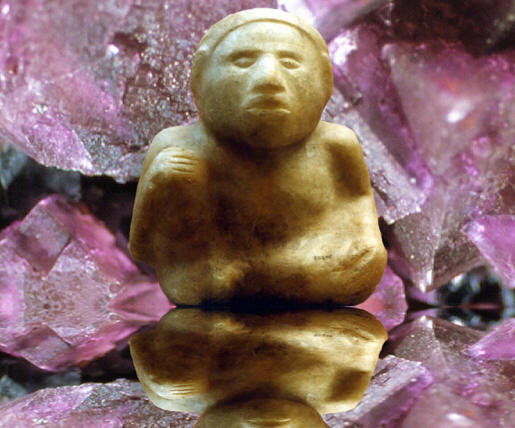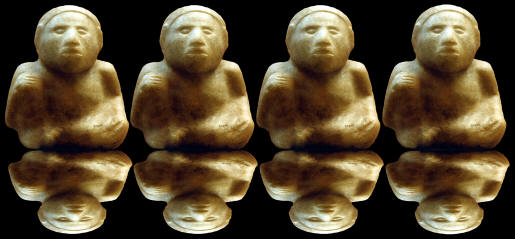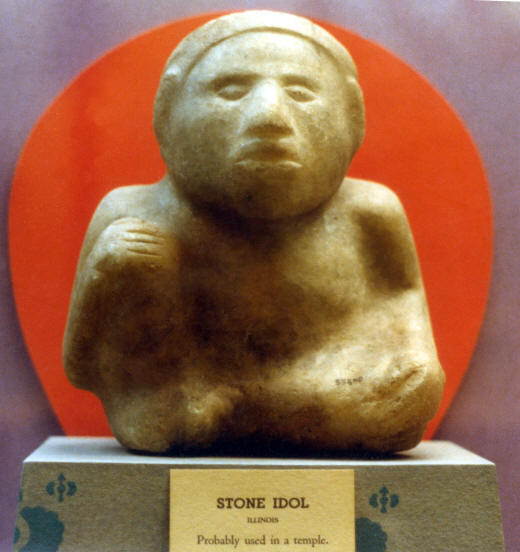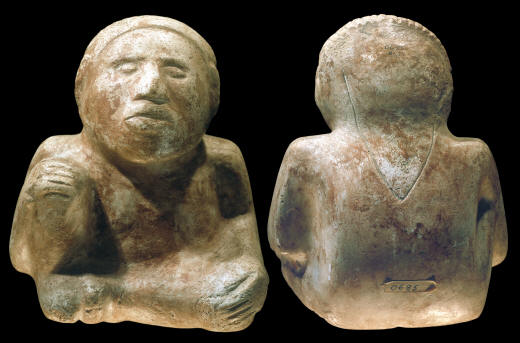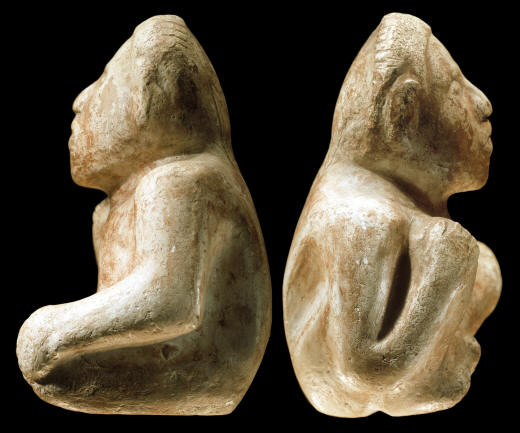|
||
|
||
|
"On November 26,
1940, the mound crew foreman sent word that something of interest had
turned up (describing the discovery
of the Angel Mound fluorite figure).
We were pleasantly surprised, therefore, when we arrived at the spot to
see that "something of interest" had indeed "turned up."-----one
of the workman, using a shovel, had noted that the shovelful of earth
that he was in the act of removing cleaved away something "shiny" that
he thought was "glass."---1967,
Glen A. Black, "Angel Site," Vol. 1, pp. 248-249.
Several different examples of carved stone human images have been found on Mississippian sites in the southeastern United States. All of them are important for the information they contain. Some examples stand out as clear and detailed representations of the Mississippian people who were alive at that time. They illustrate a variety of different hair styles, types of clothing, ornamentation and other features that help define the culture. The Anna, Angel site, Cahokia and Johnston statues, which are the focus of this article, are remarkable for the fluorite crystal they were made from. It's remarkable because fluorite is such a soft and fragile material plus the fact that at least two of the statues were recovered undamaged. In Moorhead's 1929 photograph of the Cahokia figure, it also appears to be intact. The Anna and Angel site figures were excavated from mounds in Illinois and Indiana and the Johnston figure was found in a cultivated field. The only description of the Cahokia figure is that it was found on the bluffs east of the Cahokia Mounds site. All four stone images were made from very large fluorite crystals. |
||
|
Southern Illinois is the largest producer of fluorite in the United States. The name originates from the Latin word fluere which means to flow. Fluorite is the natural crystalline form of calcium fluoride (CaF2). It's considered a soft material with a hardness scale of 4. It's appearance is described as "glassy" and ranges in opacity, from translucent to semi-translucent. The most common color is deep purple but it comes in a variety of colors such as blue, green, yellow, pink, rose and black. Some types of fluorite will glow under ultra violet light, hence the name fluorescence. The Illinois fluorite was formed by hot water flowing up into the limestone which formed mineral deposits called hydrothermal deposits. Fluorite has several important industrial uses, such as a flux in the production of steel, the production of hydrofluoric acid and producing the opalescent effect in glass. The Mississippian people acquired fluorite from natural outcrops in southern Illinois and in Kentucky. They used the material for the production of ornaments and statues. |
||
|
This article illustrates two different images of the Anna figure. One shows the original figure as it once appeared on display in the Chicago Field Museum. The other representation is a plaster cast that was molded from the original sometime in the late 1800's for a display that included casts of other North American artifacts for the Chicago World's Fair in 1893. The casting project is reported to have occurred at Princeton University. This cast is located in Lithic Casting Lab's collection of casts. The Smithsonian is also reported to have a cast. |
||
|
The Anna figure is reported to have been discovered by Thomas M. Perrine while excavating a mound in Union County, Illinois in 1873. Thomas Wilson reports in 1896, "Prehistoric Art," under a drawing of the Anna figure, which he claims to be "a specimen of the same type" from Union County, that it's made of clay. But in fact the drawing must have been copied from the Smithsonian's cast of the Anna figure. No other figure of this type and size is known from Union County, Illinois. Also, Mr. T. M. Perrine reported that the figure he discovered was made of white porphyry. The Anna figure material was finally correctly identified as fluorspar or fluorite by Wilson in 1898. The Anna figure was in fact made from a large "yellowish" semi-translucent fluorite crystal. |
||
| CONTINUE ON TO PAGE TWO | ||
|
"REFERENCES"
1896,
Wilson, Thomas, Smithsonian Annual report,
"Prehistoric Art: Or The Origin Of Art As Manifested In The Works Of
Prehistoric Man," pp. 480-481. |
||
